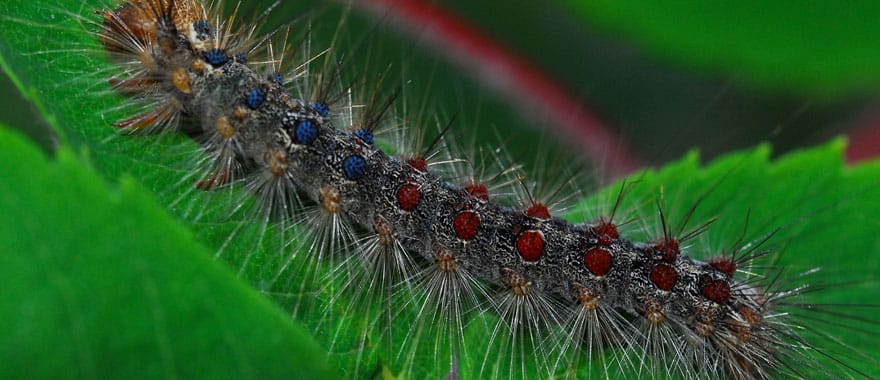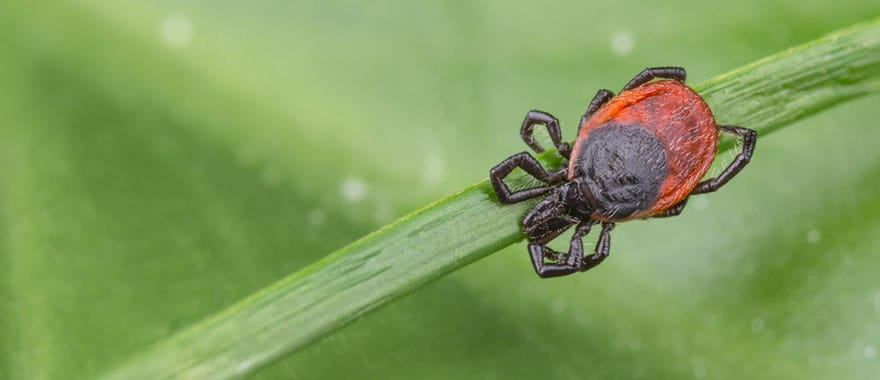
Gypsy Moth Attacking Your Trees?
Call Today For a Complimentary Inspection & Treatment Estimate
203-240-1302
We’ve been relatively lucky so far in the Danbury area and Fairfield County – most of the recent gypsy moth infestations and the resulting defoliation of trees took place in eastern Connecticut. But this year could turn out to be much worse for us.
What Is a Gypsy Moth?
The gypsy moth is a small nondescript moth that’s usually active for a short period of time in mid to late July. It’s not the moth we need to worry about though – it’s the caterpillars.
You’ve probably seen gypsy moth caterpillars before. They’re hairy critters with a double row of blue and red dots down their back. And they hang from trees by thin silk threads, getting in your hair and on your clothes whenever you walk under a tree. Ugh.
The female gypsy moth lays eggs in a mass of up to 1000 eggs that hatch into caterpillars in late April to early May. The caterpillars climb up into nearby trees and start eating – and eating and eating …
Their favorite plant to eat seems to be oak trees, although they’ll also munch their way through apple, birch, poplar and willow. They’ll generally leave conifers alone, except during a heavy outbreak.
Gypsy Moth Damage in Connecticut
In years when we have a bad gypsy moth outbreak in Connecticut, nearly all the trees in the area will be completely defoliated. For example, in 1981 over 1.5 million acres of trees lost all their leaves.
More recently, we’ve seen an increase in the number and severity of gypsy moth outbreaks in Connecticut. 2015 saw over 180,000 acres defoliated and 2016 was even worse, with 204,167 acres affected. What’s even more concerning is that the latest outbreak saw many trees completely stripped of leaves, including trees that normally aren’t targeted by the gypsy moth, such as spruce, pine and hemlock.
A healthy tree can usually survive being defoliated once in a season. It’ll generally grow back most of its leaves before fall, although some of the tree may look a little sparse. But older or stressed trees (such as during a drought) will have difficulty regenerating leaves, may become vulnerable to attack by other insects or disease, and may not have the stored energy needed to survive through the winter.
After two or three consecutive years of defoliation, even the healthiest tree will probably die.
Why Has Gypsy Moth Damage Been Worse Lately?
For many years, the gypsy moth population in Connecticut has been controlled by a fungus called Entomophaga maimaiga. It’s harmless to humans and other animals (including pollinators and beneficial insects) but it’s deadly for the gypsy moth caterpillar.
The problem is that the fungus needs a certain amount of moisture from early season rains in May and June in order to be activated. In dry springs, like the last two years, the fungus can’t grow and spread fast enough to infect a significant number of caterpillars. As a result, we end up with a caterpillar outbreak.
How To Control Gypsy Moths
Rather than waiting to see what may happen with weather in spring and hoping that the maimaiga fungus will bring down the gypsy moth population, most homeowners choose to proactively treat their trees to control gypsy moth.
There are two ways to control the spread and amount of damage caused by gypsy moths –
- preventive treatments (such as removing egg masses) and
- directly targeting the caterpillars with a variety of insecticides.
Targeting adults (after the caterpillar stage) and pupa (before the caterpillar emerges) generally isn’t effective.
Preventive Treatments for Gypsy Moth
Prevention focuses on two things – preventing eggs from hatching and preventing caterpillars from reaching the tree canopy where they feed.
One option is to manually remove egg masses by scraping them off surfaces and destroying them (such as by drowning them in soapy water – just leaving them on the ground won’t kill them). The problem with this is that egg masses can be high up in the trees where you can’t reach them, they’re hard to see, and they can be on just about any surface, including your car! Plus, even if you eliminated all egg masses on your own property, young caterpillars can be blown in from neighboring properties.
You can also spray trees and other surfaces with a horticultural oil or insecticidal soap to completely soak egg masses. This prevents them from hatching. Be sure to do it before eggs start hatching in late April! Because you need to cover all egg masses, this is something best done by an arborist who has the spray equipment to reach all areas.
To prevent caterpillars from climbing tree trunks, you can place a band around the trunk to trap caterpillars as they climb. This is usually a folded piece of burlap or a sticky band. You’ll have to kill the trapped caterpillars so this isn’t something for the squeamish person!
Chemical & Biological Treatments for Gypsy Moth
These types of treatments are best applied by a CT Licensed Arborist who has the spray or tree injection equipment necessary to get full coverage of all trees on your property. And some treatments can only be applied by a Licensed Arborist who’s licensed by the CT Department of Energy and Environmental Protection (DEEP).
The best results are achieved after the caterpillars have hatched but are still relatively young – some time in mid-May to mid-June. It usually only requires one treatment, although if there’s a heavy outbreak or your neighbor hasn’t treated their trees, you may need a second treatment.
How Barts Controls Gypsy Moth
We prefer to avoid spraying when possible (it can be hard to control exactly where the spray goes when spraying large trees and some residents have health and safety concerns about insecticidal sprays).
Instead, we use TREE-äge® from Arborjet – a highly effective insecticide with a long residual (meaning that it stays active in the tree for a couple of years) that’s injected directly into the tree trunk. We find that this systemic approach (meaning that the treatment is dispersed throughout the entire tree, not just on the surface or on some parts) is much more effective than foliar sprays.
And, because it’s injected into the tree, there’s no risk of chemical exposure to you, your family or pets on your property.
Plus, your trees only need treatment every two years instead of annually.
Although you can treat with TREE-äge at any time during the growing season, September is the ideal time to do a tree injection to protect your trees from gypsy moths. This means that the trees are fully protected going into next year’s growing season.
Call us today at 203-240-1302 to set up a complimentary gypsy moth consultation. We’ll take a look at your trees, discuss your treatment preferences and recommend the best option for controlling gypsy moth on your property.



